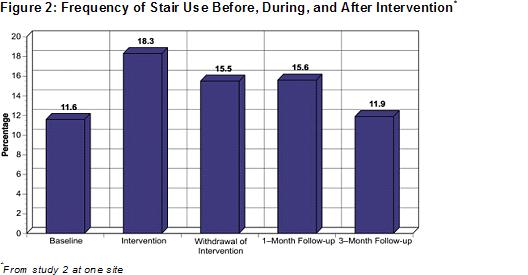Program Synopsis
Designed to increase physical activity among sedentary individuals, this intervention places signs with a healthy heart message near the stairs/escalator to encourage those nearby to use to the stairs. The studies showed an increase in stair use.
Program Highlights
Program Materials
Preview, download, or order free materials on a CD
Program Scores
The Need
Physical inactivity is associated with several medical disorders, including obesity and coronary heart disease. Obese persons are less active than their thin counterparts. Inactivity can be both a cause and consequence of obesity, but it is known that exercise decreases body fat in obese humans and animals. Coronary heart disease is more common among sedentary persons than among physically active ones. Furthermore, physical activity may protect individuals against coronary heart disease, and persons with coronary disease may benefit from physical training.
The physiological effects of exercise have been studied under experimental conditions, but little is known about patterns of physical activity in the natural environment. In many public places, stairs and escalators are adjacent, giving people an opportunity to choose one or the other. Observation of persons making this choice provides an unobtrusive measure of physical activity in natural settings.
The Program
The intervention consists of placing a sign at the stairs/escalator choice point. The sign measures 3 feet by 3.5 feet and encourages subjects to use the stairs with the message: "Your heart needs exercise...Here's your chance". The sign can be placed at any stair/escalator choice point in public places.
Community Preventive Services Task Force Finding
 This program uses an intervention approach recommended by the Community Preventive Services Task Force: point-of-decision prompts to encourage use of stairs (Physical Activity).
This program uses an intervention approach recommended by the Community Preventive Services Task Force: point-of-decision prompts to encourage use of stairs (Physical Activity).
Time Required
This intervention requires virtually no time to implement as it consists of displaying the sign at the stairs/escalator choice point. If displaying the sign in places other than one's own institution, permission would be needed from the property manager.
Intended Audience
The intended audience for this intervention is the general public.
Suitable Settings
This intervention is suitable for stairs/escalator choice points in public places, e.g. shopping mall, train station, and bus terminal.
Required Resources
The only required resource is the sign.
About the Study
Two studies were conducted to measure the relative frequency of use of stairs and escalators and to assess the impact of an intervention designed to increase physical activity. The first study assessed the effects of intermittent use of the intervention. A total of 21,091 observations were made of people going up stairs or escalators in three public places (shopping mall, train station, bus terminal). Persons carrying baggage or items larger than an attache case were excluded, as were children. Observations at each site were made once a week for 8 weeks, on the same day of the week during the same hours: 11:30 a.m. to 1:00 p.m. for the shopping mall, 7:30 a.m. to 9:30 a.m. for the train station, and 3:30 p.m. to 5:30 p.m. for the bus terminal. The first 2 weeks were considered the baseline period with no intervention. The next 2 weeks consisted of observations made with the sign displayed. The final 4 weeks were a repeat of the first 4 weeks (ABAB experimental design).
The second study was designed to address two issues raised by the first study. First, repeated exposure to the intervention was evaluated. Second, the long-term maintenance of changes in activity was measured by presumably observing the same group of people over time. Observations were made at a commuter train station in the business district from 7:30 a.m. to 9:00 a.m. on weekdays. A total of 24,603 observations were made. The authors postulate that they were likely observing the same people each day since observations were made before commercial businesses opened, there were few tourists in this part of the city, and because the same trains entered the station during the observation hours. Baseline observations were made for 5 consecutive days. The same sign as the one used in study 1 was then displayed for 15 consecutive days. A 10-day withdrawal-of-intervention phase followed (no sign). Then two 1-week follow-up phases were completed (no sign), 1 month and 3 months after the last day of the intervention (ABA experimental design).
Key Findings
- In study 1, the percentage of subjects using the stairs increased from the first baseline to the first intervention phase (5.3% to 13.7%), then decreased when the sign was removed (7.1%), and increased again when the sign was reinstituted (15%). An average of 6.3% of the subjects used the stairs during the two baseline phases and 14.4% during the two phases when the sign was used (p<.0001).

- In study 2, the percentage of subjects using the stairs increased significantly from the baseline (11.6%) to the 3-week intervention phase (18.3%; p<.0001). This increase in stair use persisted with no decline for the 15 days the sign was in place. After the sign was removed, stair use decreased promptly, but remained significantly higher than baseline levels for at least 1 month (p<.05). Stair use finally declined to baseline levels by the 3-month follow-up.





